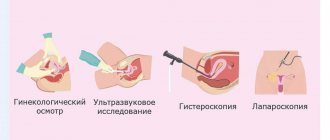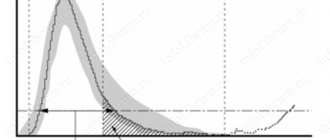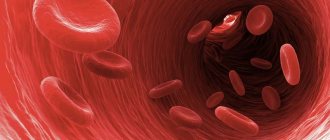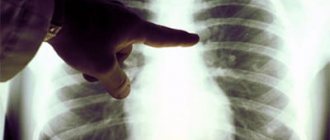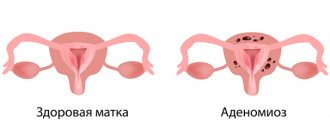To verify the proper functioning of the liver or to identify possible pathologies of this organ, it is worth using one of the simplest, most affordable and very effective diagnostic methods - ultrasound examination of the liver. Ultrasound differs from most other studies in the complete absence of contraindications and side effects, non-invasiveness, and painlessness. Using ultrasound, it is possible to identify liver pathologies even at the very beginning of their development and, therefore, begin the necessary treatment on time.
- Indications for liver ultrasound
- Normal indicators
- Preparation
- How is the ultrasound procedure performed?
- What diseases can be detected
Indications for liver ultrasound?
You should sign up for an ultrasound scan if:
- You have received a negative result from the relevant laboratory tests
- You experience discomfort or pain in the liver area
- You have suspicions or confirmation of early stage cancer pathologies
- You want to check your liver condition as a preventive measure.
If you want to be examined by truly competent specialists, do it at our medical center. You will be able to find out about the condition of your liver at the moment - whether it is completely healthy, whether there are any pathologies or damage. Early diagnosis is the key to successful treatment of many diseases, so you should not delay it, especially if there are existing indications.
Normal findings on liver ultrasound
A healthy liver has smooth, clearly defined edges and a homogeneous, unchanged structure. The anteroposterior size of the right lobe should not exceed 12 cm, the left - 7 cm. The permissible diameter of the portal vein is up to 1.3 cm, the bile duct - up to 7 mm.
The liver on the lower side should have a sharp shape. And in the area of the left side, the dimensions of this organ should have an inclination angle of 45 degrees. And on the right side - 75 degrees.
If the condition of the liver is within normal limits, then the portal vein should be clearly visible in the middle, and the right vein should be located below along a long section.
The contours of the liver in a normal state must be as clear and even as possible. The structure of this organ contains identical distributions of signals according to their intensity, as well as a uniform distribution of ligaments, vessels and other elements. And the inferior vein of the liver looks a little like a ribbon circle with a diameter of about 15 mm.
The portal vein, which is located near the porta hepatis, is formed from the superior and splenic veins. There are no walls inside it, and a growing lumen is also noticeable, which increases from the periphery.
Therefore, normal indicators of an ultrasound examination of the liver are a uniform contour with a size of about 10-12 cm. In this case, the signals are evenly distributed along the perimeter. Portal vessels can be seen in the periphery.
It should also be noted that the liver is very closely related to the gallbladder. That is why this organ, together with the liver, is also monitored during an ultrasound examination. The size of the bladder should be no more than 7 cm in length, the walls should be about 3 mm thick, and the internal space should be filled evenly with a small amount of bile of uniform consistency.
The gallbladder ducts must have a diameter of no more than 9 mm. There should be a large number of them.
If the gallbladder is enlarged in size, this indicates that there is too much biological fluid inside it. And if it is reduced, then this indicates biliary dyskinesia.
Also, during an ultrasound examination, cholecystitis of any stage can be detected. Indeed, with such an examination, the remainder of all the bile inside or the presence of various stones in the organs is very clearly visible.
If we talk about ducts, then pathology can be considered areas where they expand or narrow, and the presence of cysts can also be pathology. A variety of polyps, pumps, and other neoplasms can also be considered abnormal phenomena. Therefore, it is necessary to prescribe appropriate treatment in such cases.
Grain level: norm and deviations
Calcifications in the liver - what is it?
When performing an ultrasound examination, the fine-grained structure of the parenchyma is clearly visible, which is the norm. It is the degree of granularity of the liver that is a criterion for its condition.
Also visible on ultrasound are the bile ducts and blood vessels with a diameter of 1 mm, as well as a large portal vein, the diameter of which should be from 8 to 12 mm. If this indicator exceeds 14 mm, this means the onset of portal hypertension in a person.
During the examination, swelling of the connective tissue is often recorded; it looks flabby and pale, with a large number of protein inclusions. With the naked eye, the doctor notices increased granularity. This may be evidence of an infectious or invasive (parasitic) disease, intoxication of the body, or the inflammatory process of malnutrition. After eliminating the cause that caused such disorders, the organ will fully recover. But if the problem is ignored, over time it can lead to the formation of gallstones.
A coarse-grained liver structure and a medium-grained liver structure may indicate a metabolic disorder in the body, for example, diabetes mellitus and fatty liver disease, or a viral infection such as hepatitis C. Unfortunately, in such cases, the results of an ultrasound examination are not enough to make a correct diagnosis, therefore patients with such changes in the organ are sent for additional tests.
A diffusely heterogeneous, or coarse-grained structure is also very clearly visible during ultrasound examination. The contour of the liver changes noticeably: it seems to be completely covered with tubercles of different sizes. This state of affairs, as a rule, means cirrhosis, but it can also be obstruction of the bile ducts, infiltration of hepatocytes or their degeneration, a decrease or increase in the area of connective tissue. Ultrasound in such situations helps the doctor determine at what stage the disease is occurring, confirmed by complex diagnostics, the nature of its course and the optimal method of therapy.
Preparation for the liver ultrasound procedure
Before performing an ultrasound of the liver, it is not advisable to eat food for at least five hours (it is better to wait eight). Therefore, if you have a study scheduled in the morning, do not have breakfast under any circumstances. If the ultrasound is scheduled for the day or evening, a light breakfast is acceptable, but during the day preceding the examination, you should not eat foods that are excessively rich in fat. It is also recommended a few days before the ultrasound to control fiber intake (it increases gas formation, which, in turn, negatively affects the results of the study), not to drink carbonated drinks and, of course, to refrain from drinking any types of alcoholic beverages. If you suffer from excess weight in the obesity stage, you will need an enema about a day before the procedure itself, which will contribute to more accurate ultrasound results.
1.General information
Liver dystrophy is a group of diseases in which degeneration of the liver parenchyma (the main functional tissue consisting of hepatocyte cells) occurs and its replacement by unspecialized, undifferentiated tissues. There are several types of hepatic dystrophy: they distinguish, in particular, parenchymal protein dystrophy (which in turn is divided into granular, hydropic and hyaline); parenchymal carbohydrate, mesenchymal, parenchymal fatty (disseminated, zonal, diffuse large-droplet or small-droplet forms of fatty liver).
Most often, liver dystrophy “by default” means fatty degeneration.
A separate nosological unit is fatty hepatosis: a degenerative-dystrophic process of such high intensity that more than half of the total liver mass is accounted for by fatty inclusions in hepatocytes (normally this figure should not exceed 5%).
A must read! Help with treatment and hospitalization!
How is the liver ultrasound procedure performed?
The duration of a liver ultrasound is not too long - as a rule, it is about twenty minutes. The specialist carefully examines the condition of the liver, paying attention to the uniformity of its structure, size, and appearance. Thus, the organ is diagnosed, which makes it possible to identify at an early stage most pathologies that can be subsequently corrected with medication.
During the study, the patient lies on the couch on his side or back. To obtain accurate results, a special gel is used to increase the contact of the device’s sensors with the skin of the person being examined. The ultrasound specialist examines several longitudinal sections of the organ one by one, observing the condition of each of them. In some cases, the patient may be in a standing position to obtain more accurate results. The entire procedure does not cause any negative sensations, it is completely painless and does not require any special conditions.
Therefore, if you think that you should have your liver checked, if you are concerned about the soreness of the organ, there is no need to delay undergoing ultrasound diagnostics and medical supervision. About ninety percent of liver diseases can be detected and treated in the early stages, and ultrasound is the most favorable method for this. We guarantee that you will receive qualified and competent assistance, and the reasonable cost of the procedure will be another good news.
What liver diseases can ultrasound help detect?
Due to its high information content and accuracy, ultrasound can identify many pathological conditions of the liver.
Hepatoma (hepatocellular carcioma)
Among all malignant liver tumors, hepatoma is the most common and can occur in a diffuse or local form. It grows quickly, so it is important to diagnose it as early as possible. The development of this disease is associated with organ damage such as cirrhosis, hemochromatosis, and various forms of hepatitis.
Metastases
Metastases are detected several times more often than primary malignant neoplasms, and in most cases they are multiple in nature.
Acute or chronic hepatitis
The causes of this disease can be viral forms of hepatitis, septic bacterial infections, and intestinal infections. In the chronic form, changes in the organ are diagnosed, such as an increase in the size of the liver, loss of homogeneity of the structure, fibrosis, etc.
Budd-Chiari syndrome
The cause of this pathology is blockage of the outflow of venous blood in the veins of the organ, as a result of which the hepatic veins are not visible during the study, and the caudate lobe appears enlarged in size.
Cirrhosis of the liver
Depending on the stage of the disease, the size of the organ changes: with early diagnosis, the liver looks enlarged, in the later stages of the disease the organ is reduced.
The sooner you start treatment, the greater the chances of a full recovery - which is why diagnosis as early as possible is essential. In our medical center, a liver ultrasound will be performed quickly and professionally, which will help you get a more complete picture of the condition of your body.
4.Treatment
The therapeutic strategy is developed based on the established causes and rates of dystrophy. In most cases, treatment begins with normalizing the diet and prescribing hepatoprotective agents, usually of plant origin (Essentiale, Hepabene, etc.). Early detection of a pathological process and timely treatment of it leads to good results and therapeutic success. In more complex cases, regular cleansing enemas, “intestinal” antibiotics, vitamins, glucocorticosteroids, potassium supplements, blood transfusions, hemodialysis for renal failure, and antipsychotics are necessary for mental disorders. The rapidly increasing functional failure of the liver leads to general intoxication, and the only way to save the patient’s life is often an immediate liver transplant - which, for obvious reasons, is extremely problematic, and most often impossible.
At the same time, fatty infiltration of the liver, i.e. the accumulation of lipid compounds in large volumes inside hepatocytes, sometimes with breakthrough of the latter and the formation of fatty cysts, allows the reverse development of the pathological process and can be successfully treated. The condition is strict adherence to the diet and adherence to all medical prescriptions.



